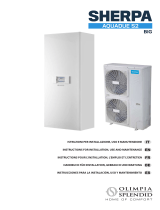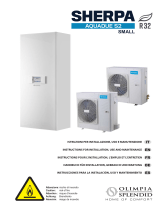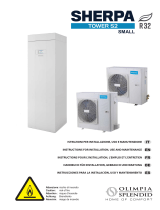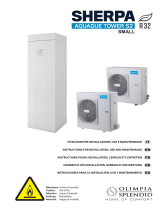This marking indicates that this product should not be disposed with other household
wastes in the entire EU. To prevent any harm to the environment or human health caused
by incorrect disposal of Waste Electrical and Electronic Equipment (WEEE), please return
the device using suitable collection systems, or contacting the retailer where the product
was purchased. For further information please contact the appropriate local authority.
The incorrect disposal of the product by the user will lead to the application of the
administrative sanctions envisaged by the laws in force.
All specifications are subject to modification without prior notice. Although every effort has been made
to ensure accuracy, Aermec cannot be held liable for any possible errors or omissions.
Dear customer,
Thank you for choosing an AERMEC product. It's the result of many years of experience and dedicated
design studies, and was built using first-class materials and highly advanced technologies.
The quality level is being constantly monitored, so AERMEC products are synonymous with Safety, Quality
and Reliability.
The data are subject to any modifications considered necessary to improve the product, at any time
and without prior notice.
Thank you again.
AERMEC S.p.A.
SUMMARY
Summary
1. USER INTERFACE ........................................................................................................................................ 5
1.1. Main page (Home) ...................................................................................................................................... 5
2. MENU STRUCTURE ..................................................................................................................................... 6
2.1. Function ...................................................................................................................................................... 6
2.2. View ............................................................................................................................................................. 6
2.3. Parameter ................................................................................................................................................... 7
2.4. Commission (Function) .............................................................................................................................. 7
2.5. Commission (Parameter) ........................................................................................................................... 8
2.6. General........................................................................................................................................................ 8
3. BASE FUNCTIONS ....................................................................................................................................... 8
3.1. Switching the unit on and off (On/Off .................................................................................................................................) 8
3.2. Selecting a menu ........................................................................................................................................ 9
4. Function MENU .......................................................................................................................................... 9
4.1. Navigating the menu ................................................................................................................................. 9
4.2. Setting the operating mode Mode .......................................................................................................................................9
4.3. Activating the function for fast domestic hot water production (Fast hot water) ............................... 10
4.4. Setting the priority between cooling and domestic hot water production (Cool+hot water) ............ 10
4.5. Setting the priority between heating and domestic hot water production (Heat+hot water) ........... 11
4.6. Setting the noise reduction function (Quiet mode) ................................................................................ 11
4.7. Setting the automatic setting compensation on the basis of external air (Weather depend) ............ 12
4.8. Setting a timer for programmed switch-on and/or switch-off (Weekly timer) ..................................... 13
4.9. Enabling the Holiday Program function used for the weekly timer (Holiday release) ......................... 14
4.10. Enabling/disabling the anti-legionella cycle (Disinfection) ................................................................... 14
4.11. Setting a timed switch-on/switch-off (Clock timer) ................................................................................ 16
4.12. Setting programmed setting variations on system water delivery (Temp. timer) ............................... 17
4.13. Enabling emergency operation for heating or DHW (Emergen. mode) ................................................ 18
4.14. Setting the winter period absence function (Holiday mode) ................................................................. 19
4.15. Setting the daily timer programming (Preset mode).............................................................................. 19
4.16. Deleting current errors (Error reset) ......................................................................................................... 20
4.17. WiFi connection reset function (Wifi reset) .............................................................................................. 20
4.18. Loading the default settings (Reset) ........................................................................................................ 20
5. Parameter MENU ....................................................................................................................................... 20
5.1. Navigating the menu ................................................................................................................................. 20
5.2. Setting the temperature set-points used by the unit in the various modes (WOT-Cool ~ ΔT-hot water) ....21
6. VIEW MENU ................................................................................................................................................ 22
6.1. Navigating the menu ................................................................................................................................. 22
6.2. Viewing the status of the unit components (Status) ............................................................................... 22
6.3. Viewing the status of the unit parameters (Parameter) ......................................................................... 23
6.4. Viewing the active errors on the unit (Error) ........................................................................................... 24
6.5. Viewing the error log (Error log) ............................................................................................................... 24
6.6. Viewing software information (Version) .................................................................................................. 24





























